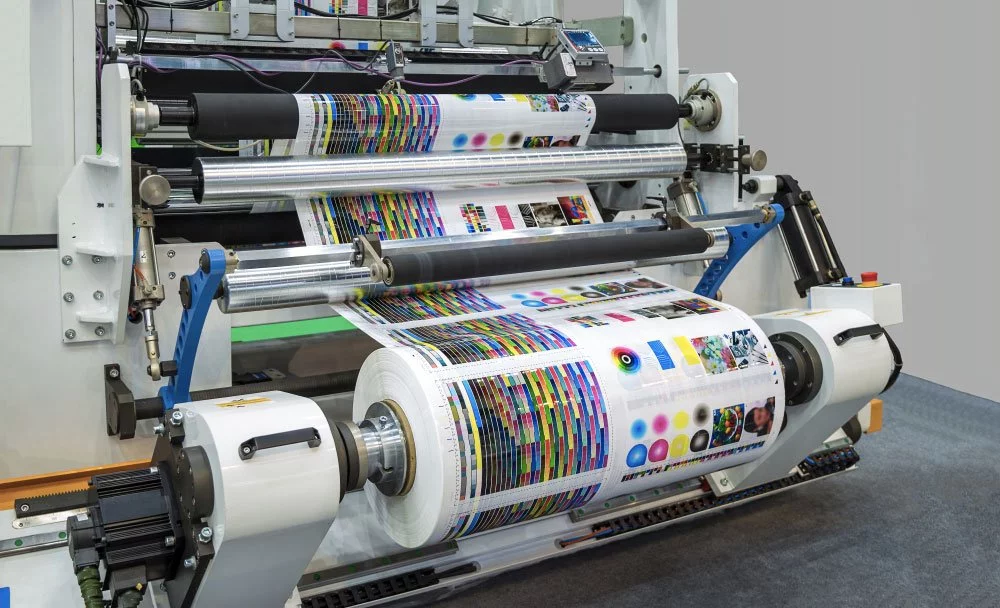Anyone who finds themselves requiring printing services is likely to come across the concept of offset printing. While this printing technology has been around since 1875, American printer Ira W. Rubel was the one to build a press to capitalize on it in 1904. Now, it’s widely used around the world as a reliable method to create brochures, posters, business cards, and other types of printed materials.
In this article, you’ll discover what is offset printing, how it works, its differences when compared to digital printing, and its many benefits.
What is Offset Printing?
Offset printing is a traditional printing technique that has been widely used since the 20th century. It works by spreading ink onto metal plates (one per color: cyan, magenta, yellow, and black) with etched images. Those plates are then transferred to a rubber blanket or any intermediary surface, and finally applied to substrates such as paper by pressing the paper against the intermediary surface.
Offset printing the most cost-effective printing technique when producing large quantities of high-quality printed materials. Although the initial set-up costs can be expensive, the actual printing process is relatively low-cost. That’s why offset printing is typically used on custom jobs that require sharp, crisp imagery and high-volume runs to save on costs.
To produce an offset printing job, you will need custom plates incorporated into your artwork. This can be done using a high-resolution paper printout or an electronic file, which can then be photographed to create film. Today, most plates are made from your electronic file.

How Does Offset Printing Work?
The offset printing process relies on the fact that oil-based inks and water do not mix. In that case, the oil-based ink won’t stick to the areas without images.
Images and text are primarily set on plates through various methods, most commonly through a chemical process that’s similar to developing film photographs. Colored inks and water are applied alternately on these plates, with the ink sticking onto the image areas and water on everything else. The images on the plate are then covered by or rolled over a rubber sheet, called a “blanket”, and from there, the image is then transferred to the substrate or paper stock. The process is then continuously repeated on several intervals for each color. The pigments are applied as tiny, minuscule dots, blended in differing proportions and quantities. When they’re on paper, the human eye sees or elucidates them as contrasting hues and shades.
When digging deeper into how offset printing works, only the portion with inked images is transferred to a cylindrical rubber blanket that then transfers the images onto the substrates or paper. This is also where the label “offset” came from as it refers to the fact that the images aren’t directly printed to the substrate from the plates. Instead, they are offset or transferred to another surface which makes contact with the substrate.

What is Digital Offset Printing?
In a previous article titled “What is Digital Printing?” we discussed its history, process, various types, and advantages. But have you ever heard of digital offset printing?
In a nutshell, digital offset printing is a type of printing technology or technique that involves charging an imaging plate using electrostatic. The discharged areas of the imaging plate receive the ink before it is directed to a heated blanket. The ink is then transferred to the photo drum before it reaches the substrate.
Color and extremely high dpi (dots per inch) capabilities are the major strengths of digital offset printing, but its weakness lies in its durability. However, laminates and coatings can be applied to safeguard or protect the images from chemical resistance and abrasion.
What is the Difference Between Digital and Offset Printing?
When talking about the differences between offset printing vs digital printing, volume usually comes to mind. As mentioned before, offset printing is the most economical choice if you want to produce large volumes of prints with few originals. Digital printing on the other hand is the quickest way to produce short runs, especially if you have many originals.
As previously mentioned, offset printing works by separating an image’s colors into various color components. Each of these colors gets its own plate and then loaded on its own plate cylinder. On the other hand, digital printing transfers the colors directly to the substrate or the paper. The most common types of digital printers are:
- Toner (powder that’s transferred through electrostatic and then heat fused onto the substrate)
- Solid Ink Printers (these use colors similar candle wax and it’s a process that’s closer to offset printing)
- Inkjet (liquid ink various formats and application methods)
Digital printing is ideal for small jobs and jobs that need constant or quick changes.
Which technique is the right fit for my project?
Generally speaking, small printing jobs with fast turnarounds are best done on digital printing machines. Digital printing machines also best achieve jobs that need variable data printing. Larger jobs that requiring special inks or papers and unparalleled quality find themselves on offset presses. Even if you don’t use metallic or fluorescent inks, the results are stunning. However, these are just general guidelines. The best way to determine which printing method is best for your project ultimately depends on your requirements.
Here’s a quick rundown to have a clearer picture of each technique’s advantages:
Advantages of Offset Printing:
- Well suited for large jobs and projects due to their cost effectiveness
- More options for papers and substrates with a variety of finishes
- The larger the run, the lower the individual cost
- Works well with specialty inks such as Pantone Inks and even metallic colors
- Unparalleled color quality and clarity that stays true to the original design
Advantages of Digital Printing:
- Low setup costs and cheaper cost per page
- Geared toward lower quantities
- Ideal for print on demand jobs (only print what you need, when you need it)
- Fast and affordable option for black-and-white print jobs
- The only printing technique that lets you perform Variable Data Printing
Is Offset Printing Better than Digital Printing?
It truly depends on what you mean by “better.” As discussed earlier, no single printing technique is overall better than the other. Depending on the size of the printing run, each technique has a significant advantage over the other.
When it comes to how offset printing works, the process generally produces higher-quality and consistent prints. Digital printers tend to produce prints with significant differences at the beginning and end of a print run. This is often due to shifts in ink properties because of overheating nozzles or ink components settling overtime. However, for short runs, digital printers tend to produce consistent prints.
As digital printers don’t require plates, they are much quicker to set up compared to an offset printer. Printing jobs that require quick turnaround time generally use digital printing technology.
The decision to use digital or offset printing boils down to the length of time you need to complete a job or project.
Is CMYK Offset Printing Better than RGB Printing?
If you’re interested in offset printing and how offset printing works, you’ll come across terms such as CMYK and RGB printing. Which one works best for offset printing?
First, let’s tackle what the acronyms actually mean. CMYK stands for Cyan, Magenta, Yellow, and Black. On the other hand, RGB stands for Red, Green, and Blue. They are both color models that combine the color components in specific amounts in order to achieve desired shades and hues.
RGB is the widely used color model for monitors and other types of electronic displays. If you are reading this article through a monitor right now, it’s highly likely that it utilizes RGB. Meanwhile, CMYK is more commonly used in all kinds of printing techniques, including digital and offset printing. The major difference is that electronic displays mix different colors of light, while printers blend colors on the substrate, thereby producing light. As the two processes are vastly different from each other, they cannot be totally compared directly.
This is mainly because the challenges involved are different. While RGB has the ability to reproduce more shades and hues in the visible spectrum, it is much easier to print technically using the CMYK color model. CMYK’s black ink cartridge also makes this color model much more economical, as colors do not need to be mixed so often to obtain the color black. Additionally, RGB and CMY (without black) on their own cannot obtain very deep blacks on print. As text requires typically requires huge quantities of black ink, this makes CMYK a better and more economical color model for printers.
Before printing, it is crucial to verify the color process your printer will be using. When it comes to most colored offset printers, RGB files will need to be converted to CMYK for processing.
The Bottomline: Offset Printing is Still a Favored Printing Technique
While personal preferences certainly play a role, it’s no debate that offset printing is still widely used today due to its many advantages. However, your choice of printing technique will ultimately be determined by quality, budget, volume demands, and time constraints. There isn’t one way that is the only way to print. But if you want the best outcomes for your project without compromising on quality, offset printing is ideal.


